 What can be said about the venerable Remington 870, a pump-handle shotgun that has not already been said? It is a highly reliable shotgun regardless of the variant. There is a Remington 870 for virtually all manner of sport, hunting, competition, law enforcement, military, and defensive purposes. My favorite shotgun, any shotgun, still remains the classic wood and steel, and Remington makes a fine one called the “Home Defense.” A Remington 870 Express “Combo” (a 26-inch vent rib barrel with Modified Rem™ Choke tube and a 20-inch fully rifled, rear-sighted deer barrel.) with walnut furniture in 12-gauge and 20-gauge is part of my family, as is the Remington Express Synthetic “Tactical” in 20-gauge that is currently the wifey’s favorite for HD. For me, a Remington 870 that incorporated the tang safety, like that on the Mossberg, would be the perfect “pumper-gun.” I have nothing against the Mossberg shotguns. In fact, I have several of those in 12-gauge and 20-gauge.
What can be said about the venerable Remington 870, a pump-handle shotgun that has not already been said? It is a highly reliable shotgun regardless of the variant. There is a Remington 870 for virtually all manner of sport, hunting, competition, law enforcement, military, and defensive purposes. My favorite shotgun, any shotgun, still remains the classic wood and steel, and Remington makes a fine one called the “Home Defense.” A Remington 870 Express “Combo” (a 26-inch vent rib barrel with Modified Rem™ Choke tube and a 20-inch fully rifled, rear-sighted deer barrel.) with walnut furniture in 12-gauge and 20-gauge is part of my family, as is the Remington Express Synthetic “Tactical” in 20-gauge that is currently the wifey’s favorite for HD. For me, a Remington 870 that incorporated the tang safety, like that on the Mossberg, would be the perfect “pumper-gun.” I have nothing against the Mossberg shotguns. In fact, I have several of those in 12-gauge and 20-gauge.
My reason for looking for another HD/PD shotgun is based on a previous experience shooting “mini” 12-gauge shells through my friends Mossberg 500, which had less recoil and associated muzzle blast than my 20-gauge Mossberg 500. Shooting the “mini” shells through the Mossberg 500, without having hang-ups when feeding, required an adapter that ensures that the shells feed properly. I did purchase the adapter, but to tell the truth, I was too lazy to install it in my life-time PD companion, Boo Boo. But, before I could get over my laziness, another shooting companion of mine told me that he had run the “mini” shells through a Remington 870 with no issue. He felt that it was because of how the ‘elevator’ was made differently than that of the Mossberg.
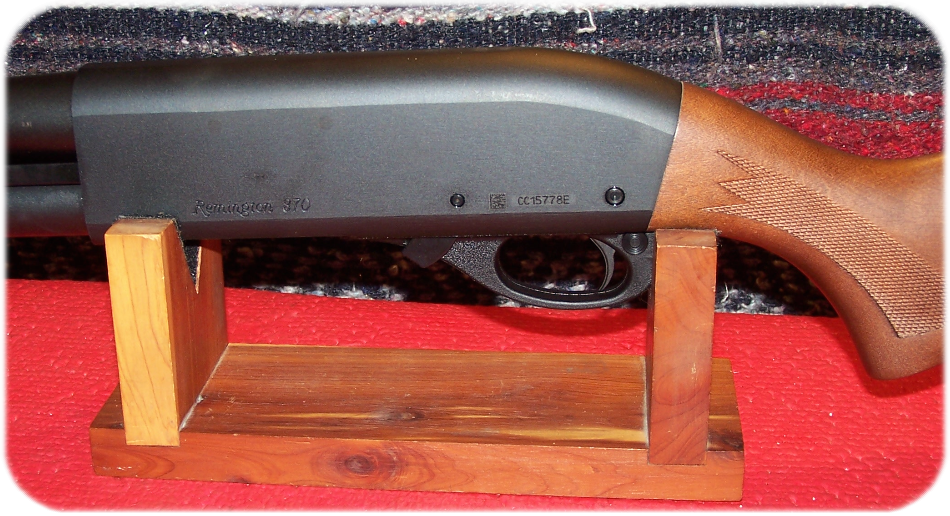
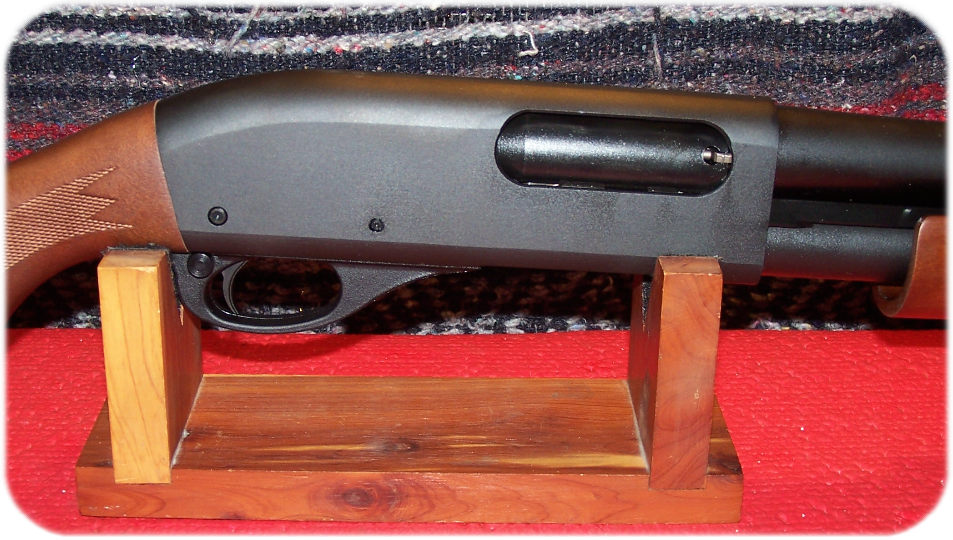 While my evil twin side of me said otherwise, the only logical solution was for me to purchase a 12-gauge pump shotgun that would fire the “mini” shells without any modification or adapter. Based on my friend’s experience (and I have him to blame if things don’t work out), a search went out for a Remington 870. As soon as I saw the “Home Defense” variation in my search, I knew which shotgun was right for me, the “Remy HD”.
While my evil twin side of me said otherwise, the only logical solution was for me to purchase a 12-gauge pump shotgun that would fire the “mini” shells without any modification or adapter. Based on my friend’s experience (and I have him to blame if things don’t work out), a search went out for a Remington 870. As soon as I saw the “Home Defense” variation in my search, I knew which shotgun was right for me, the “Remy HD”.
The ‘Remy HD” reminds me of a barracuda; sleek and deadly. The walnut hardwood stock and pump handle looks perfect with the black matte finish of the exterior metal workings, which contributes to the sleek look. The deadly part comes with the 6+1 capacity running through a 3-inch chamber.
With a 14-inch LOP, the fit of rubber recoil-padded stock to shoulder is near perfect for me. The 18.5-inch, cylinder-bore, 73-caliber smooth-bore barrel contributes to the 38.5-inch overall length and at 7.25-pounds empty you know that you are carrying something that will deliver the mail.
This is your basic shotgun with only a brass front bead to tell you where the working end is and which way the barrel is pointing. Being a left-shooter the cross-bolt safety on the rear of the trigger guard goes into the wrong direction but my support hand usually works this type of safety with no problem, although I do have to admit to liking the tang-mounted safety of the Mossberg more than the Remington’s safety.
The Remington 870 Home Defense, as most 870 shotguns these days, incorporates a key-lock safety that is part of the safety button. Personally, I don’t have a use for them, but I know how to use them. However, this model does not have a key-lock safety.
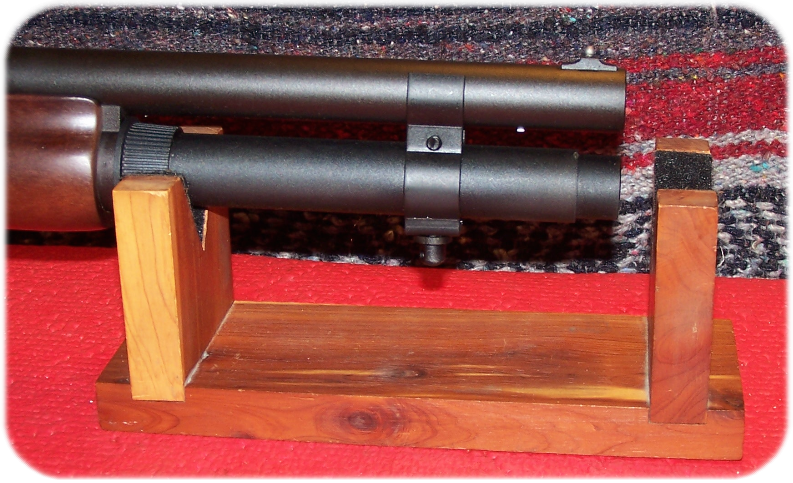 It would have been nice to provide a rear sling mount, since Remington saw fit to provide a front sling mount, but for a couple of bucks a sling swivel can be had and then mounted on the stock, which does have a sling mount location marked.
It would have been nice to provide a rear sling mount, since Remington saw fit to provide a front sling mount, but for a couple of bucks a sling swivel can be had and then mounted on the stock, which does have a sling mount location marked.
 The dark hardwood stock and forearm has some very nice grain, but don’t expect a fancy finish. This is a working shotgun and the finish is very satin-looking in appearance. There is something about wood that is just pleasing to the touch, unlike synthetic furniture.
The dark hardwood stock and forearm has some very nice grain, but don’t expect a fancy finish. This is a working shotgun and the finish is very satin-looking in appearance. There is something about wood that is just pleasing to the touch, unlike synthetic furniture.
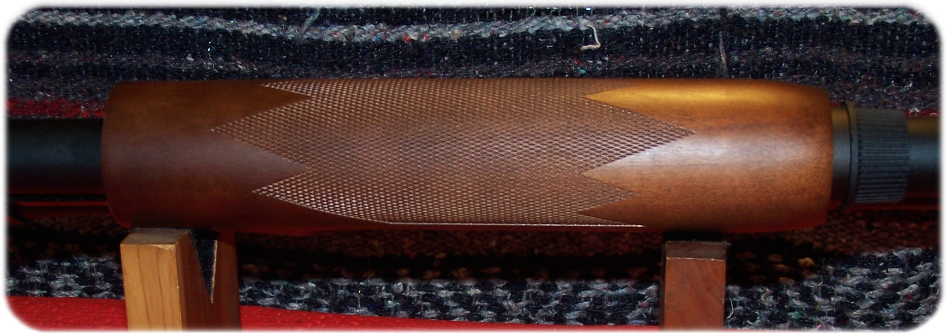 The pump handle has quite nice checkering to assist in gripping and fits the hand well. Also, there is a calming effect on the soul when you hand rub a wood stock with your favorite preservation oil that cannot be felt with a synthetic stock. But if you hand rub a synthetic stock there is something wrong with you anyway. A synthetic stock says, “Just use and abuse me;” whereas, a wood stock says, “Rub me and you will have a calming Zen moment.” Somebody should write a book and title it “Zen and the Art of Wood Gun Stock Maintenance.”
The pump handle has quite nice checkering to assist in gripping and fits the hand well. Also, there is a calming effect on the soul when you hand rub a wood stock with your favorite preservation oil that cannot be felt with a synthetic stock. But if you hand rub a synthetic stock there is something wrong with you anyway. A synthetic stock says, “Just use and abuse me;” whereas, a wood stock says, “Rub me and you will have a calming Zen moment.” Somebody should write a book and title it “Zen and the Art of Wood Gun Stock Maintenance.”
The receiver is, of course, steel as compared to the Mossberg’s aluminum receiver, but that is not saying anything against Mossberg as both shotguns lock up steel-to-steel. Unlike the receiver of the Mossberg 500; however, the receiver of the Remington 870 Home Defense is not drilled and tapped for a rail. This is your basic point-n-shoot shotgun. It is also my opinion that the Remington 870 is like comparing the Remington New Model Army Revolver (1863-1875) against the 1873 Colt revolver that won the West. The Colt was an excellent revolver, but in my mind, the Remington was much better made, was heavier, but was more expensive than the Colt. The 1872 Colt lost the Government contract, but after several modifications (some modeled from the Remington revolver) the 1873 Colt Singe-action revolver won the Government contract because of its cost and part interchangeability and not because it was the best revolver. The last Remington revolver made was in 1873 (Remington New Model Police Revolver) and Colt Single-action revolvers continued to dominate and are still in production today. But, as is my usual fashion, I digress.
TAKING THE SHORTCUT
While I had no doubt that the Remington 12-gauge Home Defense shotgun would handle full loads with aplomb, the real reason behind my purchasing the shotgun was to do some ‘short’ work.
I had ordered some NobelSports 2.25-inch 00 Buck and some Aguila 1.75-inch #1 Buck to run through the ‘Remy HD’ as an experiment with recoil, noise, and spread at 10 yards, which I consider the optimum ‘pattern’ distance inside my domicile.
The Nobel 2.25-inch 00 Buck contains 6-pellets and has an exit velocity of approximately 1250 fps. The Aguila 1.75-inch mini-shell in #1 Buck has a velocity of 1200 fps. Both should make for an excellent indoor defensive load, being light in recoil and also in generated noise. I had shot the Aguila before in my friends Mossberg 500 (with adapter) and the generated recoil was actually less than my Mossberg 20-gauge with #3 Buck loads.
The weight of the Mossberg 500 “Tactical” is 6.75 pounds compared to the Remington 870 Home Defense shotgun at 7.25 pounds. Being a little heavier than the Mossberg, I would expect a little less felt recoil out of the ‘Remy HD.’ Range time would also be a good opportunity to compare the “Mini” shells to a standard 2.75-inch 00 Buck loading. What I had planned was to load a standard 2.75-inch rifled slug first followed by two NobelSports 2.25-inch 00 Buck followed by two Aguila 1.75-inch #1 Buck loads; the first load fired would be the Aguila 1.75-inch #1 Buck loads. I was going to fire in this order and then load the same for my shooting companion. The sacrifices that I have to make to bring this good information to you!
The secret of running a ‘pump handle’ shotgun is to maintain a smooth ‘pump’ throughout the extraction, ejection, and loading cycle. Due to the length of standard shotgun fodder, there is not much room for the shell to bounce around as it is being raised by the elevator into a position to chamber. With ‘mini’ shells; however, the shells have more space to bounce around and could become mis-aligned while attempting to chamber them, and which may cause a FTF. The mini shell adapter for the Mossberg minimizes the shell movement and reduces the possibility of the shell bouncing around in the chamber. The elevator in the Remington is a solid unit rather than an open unit like the Mossberg, which reduces the possibility of ‘shell bounce’ in the loading cycle.
Another consideration is the malady of ‘short stroking.’ Short stroking or short cycling means you have not brought the bolt back far enough to eject the cartridge, which means you cannot chamber a shell, which is not what you want to happen. With ‘mini’ shells, ejection is quicker than with ejecting standard shells and there may be a tendency that once the expended shell is expelled from the chamber to not bring the action all of the way rearward, which may not allow the shotgun to cock the action even though the next mini shell may be chambered. It is important; therefore, when shooting mini-shells that you make a conscience effort to bring the action fully rearward before pushing the action forward to chamber the next shell, thus ensuring that the action is ready to fire and that there was enough space for the next shell to chamber.
The advantage of shooting mini-shells is obviously with increased load capacity. With the Remy HD, and with 2.25” mini-shells, you get a 7+1 capacity. With 1.75” mini-shells, that capacity is upped to 10+1.
With all that said, I did have an issue shucking the 1.75-inch shells. However, the issue was not with the shotgun, but was with me. I was not being forceful enough bringing the pump handle to the rear fast enough for the ‘shorty’ shells to clear the chamber. Since the shotgun is new, the action is really stiff and I am sure that as the shotgun breaks in I will have less a problem with mini-shells. The 2.25-inch shells were better and the standard 2.75-inch shells were excellent in being ejected.
Pretty Paper Patterns
With the above said, the ‘Remy HD’ performed flawlessly in my hands and that of my shooting companion. Ten yards seems to be an optimum distance for these mini shells as the shot pattern expands a lot after ten yards. Recoil, as expected, was minimal. Running a pistol grip on a shotgun that is used to fire mini shells would be no problem. I can’t say the same for pistol grip-only shotguns that fire full-load and magnum fodder (I actually broke a Choate pistol grip at the receiver mount on “Boo Boo” when firing slugs and I now like full stocks on my shotguns (or a combination of stock and pistol grip). Using a pistol grip with a shoulder-mount shotgun is alright, but no more pistol grip-only shotguns for me).
Due to the lack of recoil when shooting “mini shells,’ there is a lack of muzzle rise that would be attributed to full-power loads. The mini-shells are not only comfortable to shoot, even with a lightweight shotgun, but also allow you to stay on target when shooting repeatedly; with standard loads, and even with low-power slugs, the same cannot be said.
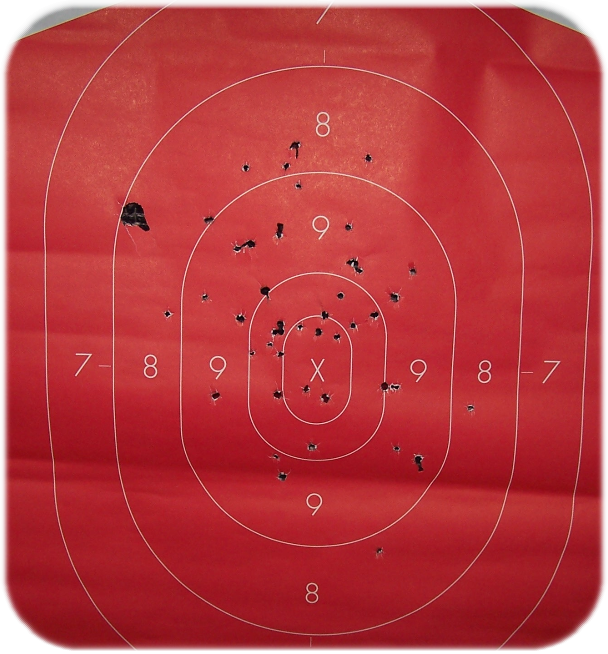
Two Rounds of Aguila 1.75-inch #1 Buck Pattern at Ten Yards.
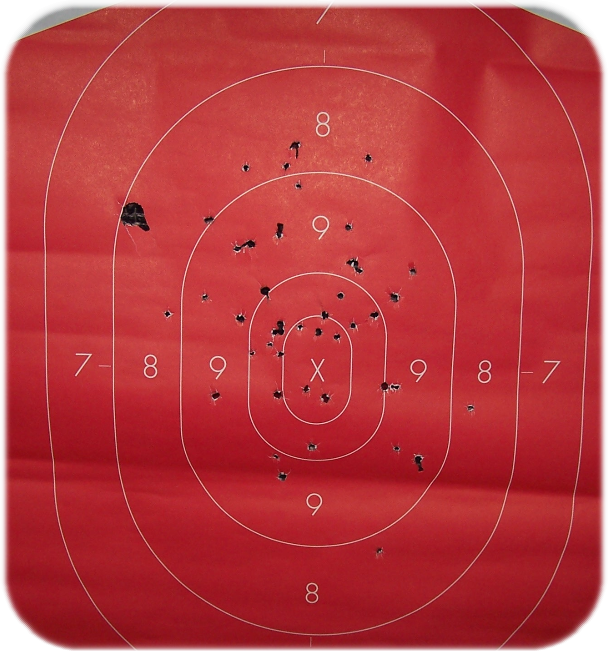
Two rounds of Nobel Sports 2.25-inch 00 Buck at Ten yards.
The Federal Reduced Recoil 2.75-inch, 1-ounce Rifled Slugs (1300fps) shot point-of-aim and felt recoil was somewhat greater than with the Nobel Sport 00 Buck loads, but less than full-up powered slugs.
Personally, the 1.75-inch and 2.25-inch shells would be a good choice for indoor or outdoor, close-in work. For distances past 10-yards, I would rather rely on full-power loads to extend the range, maximize the impact on the target, and keep the spread as tight as possible.
The Federal Reduced Recoil 2.75-inch, 1-ounce Rifled Slugs is still a powerful round even in reduced load at close distances. Sending a 1-ounce, .73 caliber rifled slug downrange at around 1300 fps is still pretty impressive, as they are intended for light, thin-skinned game such as white tail deer. They should be as effective on thin-skinned, two-legged creatures that are intent on doing harm to you as well.
I have acquired some Aguila 1.75-inch MiniShell lead slugs, which weigh out at 7/8-ounce and which are rated at 1250fps, which is only 50fps slower than the Federal Low-recoil 1-ounce rifled slug. I am interested to see how the Aguila slug performs, especially in cycling through the chamber in a later session.
Upgrades
Of the many upgrades available for the Remington 870 (see References), I will probably upgrade the magazine follower to a stainless-steel version. Plastic magazine followers are fine at first, but with use and time polymer degrades and I just feel a need to interfere with that. Other than that, I have no issues with the Remy HD.
And, to Summarize
For close-range, indoor home or self-defense, the Remington 870 Home Defense shotgun stoked with mini shells would be an excellent combination. If mini shells are not in your tactical mindset, the Remington 870 Home Defense shotgun is a very formidable tool when used with full-power standard and magnum loads. So, if you are a wood-n-steel kind of person, I can highly recommend the Remington 870 Home Defense shotgun. Even if you are not a wood-n-steel person, the synthetic Remington 870 Tactical version is an excellent choice.
MSRP for the Remington 870 Home Defense shotgun is $420, but can be found for less.
REFERENCES:
- MODEL 870 HARDWOOD HOME DEFENSE: https://www.remington.com/shotguns/pump-action/model-870/model-870-hardwood-home-defense
- NobelSport Minibuck 12 Ga 2.25″ 00 Buck 6 Pellets 10 Rounds: https://www.cheaperthandirt.com/product/ammo-12-gauge-nobelsport-minibuck-2-1-4-00-buck-6-pellet-lead-1250-fps-10-round-box-ans12200bk10-837913000380.do?from=Search&cx=0
- Aguila MiniShells 12 Gauge Ammunition 20 Rounds 1-3/4″ #4 Buckshot 5/8 Ounce 1200fps: https://www.cheaperthandirt.com/product/aguila-minishells-12-gauge-ammunition-20-rounds-1-3-4-4-buckshot-5-8-ounce-1200fps-640420002538.do?from=Search&cx=0
SEE ALSO:
Seven Remington 870 Upgrades for less than 20 Bucks: http://www.rem870.com/2012/11/23/7-remington-870-upgrade-ideas-for-less-than-20/
10 Must Have Upgrades for Your Remington 870 Shotgun : http://www.rem870.com/2012/10/17/10-must-have-upgrades-for-your-remington-870-shotgun-2/
10 Steps to Upgrade Your Remington 870 Express to Police Version: http://www.rem870.com/2013/08/13/10-steps-to-upgrade-your-remington-870-express-to-police-version-2/
![]()

